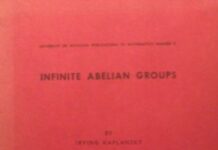
Ebook Info
- Published: 2001
- Number of pages: 140 pages
- Format: PDF
- File Size: 6.79 MB
- Authors: Irving Kaplansky
Description
This book is based on notes from a course on set theory and metric spaces taught by Edwin Spanier, and also incorporates with his permission numerous exercises from those notes. The volume includes an Appendix that helps bridge the gap between metric and topological spaces, a Selected Bibliography, and an Index.
User’s Reviews
Editorial Reviews: Review “This is a book that could profitably be read by many graduate students or by seniors in strong major programs … has a number of good features. There are many informal comments scattered between the formal development of theorems and these are done in a light and pleasant style. … There is a complete proof of the equivalence of the axiom of choice, Zorn’s Lemma, and well-ordering, as well as a discussion of the use of these concepts. There is also an interesting discussion of the continuum problem … The presentation of metric spaces before topological spaces … should be welcomed by most students, since metric spaces are much closer to the ideas of Euclidean spaces with which they are already familiar.” —- Canadian Mathematical Bulletin
“Kaplansky has a well-deserved reputation for his expository talents. The selection of topics is excellent.” — –Lance Small, UC San Diego”Kaplansky has a well-deserved reputation for his expository talents. The selection of topics is excellent.” —- Lance Small, UC San Diego
Reviews from Amazon users which were colected at the time this book was published on the website:
⭐This is an exceptionally good introduction to the core definitions and theorems of naive set theory.That is to say, it is written in an informal style, yet remains adequate for building deeper knowledge later. I found the treatment somewhat idiosyncratic in that it gives some insights about how Kaplansky views sets and some natural proofs of their properties. Note: this last point suggests the following analogy: you’re in college and you take two logic classes just because you love logic so much. However, both are taught by different teachers. One teacher simply goes from the text; the other one hands out a set of lecture notes that is very personal and interesting and adds insight to the textbook. Kaplansky’s work is this set of lecture notes. It is also rare to find coverage of metric spaces in a work of its kind, which adds to its appeal. This book is brief, but is not intended to pry beyond the bare essentials — the written style is ideally suited to this end. A pleasure to read! Highly recommended for a first go.
⭐This is a very good book especially for self-study. It is very good for the material ittreats but some caveats need to be noted. The set theory is naive and not axiomatic.Zorn’s lemma, well-ordering theorem, and point-set theory are covered — butPeano’s axioms are not. There is no coverage of Real Numbers or Ordinals.For the topics that are treated the coverage is very good, and book is well-organizedand lucid. The development is logical and rigorous; the language is very helpful inunderstanding the material, as are the historical asides. There are plenty of niceexercises. The material is pitched at the advanced undergraduate or beginning graduate level.Classic Set Theory by Goldrei is very good too.
⭐I didn’t give 5 stars only because of the lack of any proofs or rigor. However it is well written and quite pleasant to read. If you are a beginner looking to study naive set theory, I recommend. Or if you just want a refresher or light reading.
⭐Difficulty of the material is inversely proportional to the thickness of the book, it is a thin book but exceptionally good in presenting the material concisely.
⭐I got this book while I was a senior undergraduate and found the topics inside to be almost essential in graduate school. Some universities will cover this material at the undergraduate level, but lots of them do not (like mine) because most undergraduates do not go on to graduate school and do not want or need these kinds of topics. I found this book easy to read and covers a nice range of topics. Kaplansky is a famous mathematician and any undergraduate who plans on going to graduate school and has not covered topics like ordinal and cardinal numbers, axiom of choice, Zorn’s Lemma, well ordering principle, etc.
⭐Kaplansky’s Set Theory and Metric Spaces is one of the most helpful math books that I’ve ever used. Begining with basic set theory and covering such topics as cardinal numbers, countability, the Axiom of Choice, Zorn’s Lemma, well ordering, basic properties of metric spaces, completeness, separability, and compactness, this book covered all of the main topics in my set theory class. Kaplansky’s explanations are clear and concise, his examples are illuminating, and the problems are challenging without being far too difficult. As a bonus, this book is quite resonably priced. A must for anyone who is taking a first or second set theory class!
Keywords
Free Download Set Theory and Metric Spaces (AMS Chelsea Publishing) 2nd Edition in PDF format
Set Theory and Metric Spaces (AMS Chelsea Publishing) 2nd Edition PDF Free Download
Download Set Theory and Metric Spaces (AMS Chelsea Publishing) 2nd Edition 2001 PDF Free
Set Theory and Metric Spaces (AMS Chelsea Publishing) 2nd Edition 2001 PDF Free Download
Download Set Theory and Metric Spaces (AMS Chelsea Publishing) 2nd Edition PDF
Free Download Ebook Set Theory and Metric Spaces (AMS Chelsea Publishing) 2nd Edition
